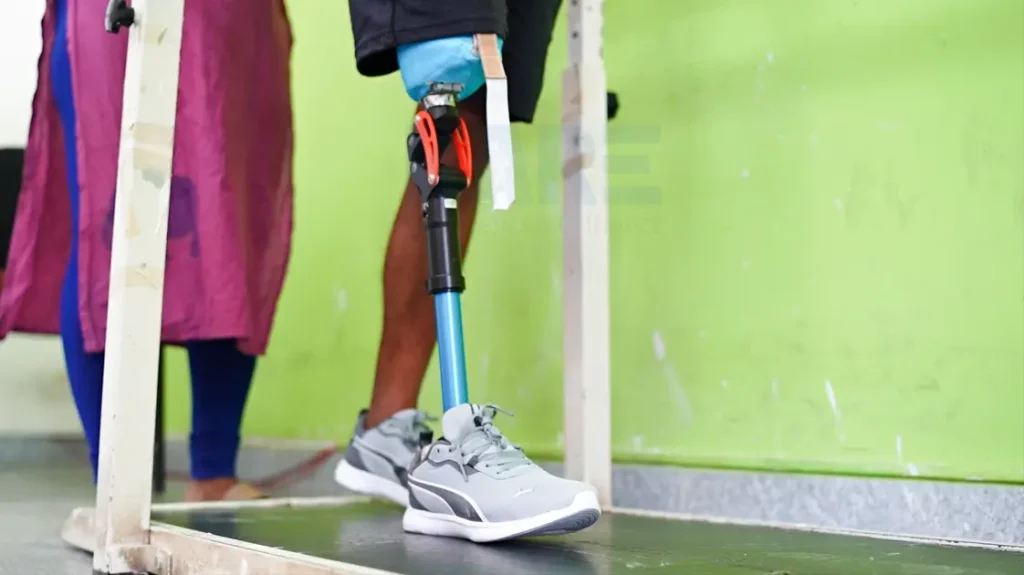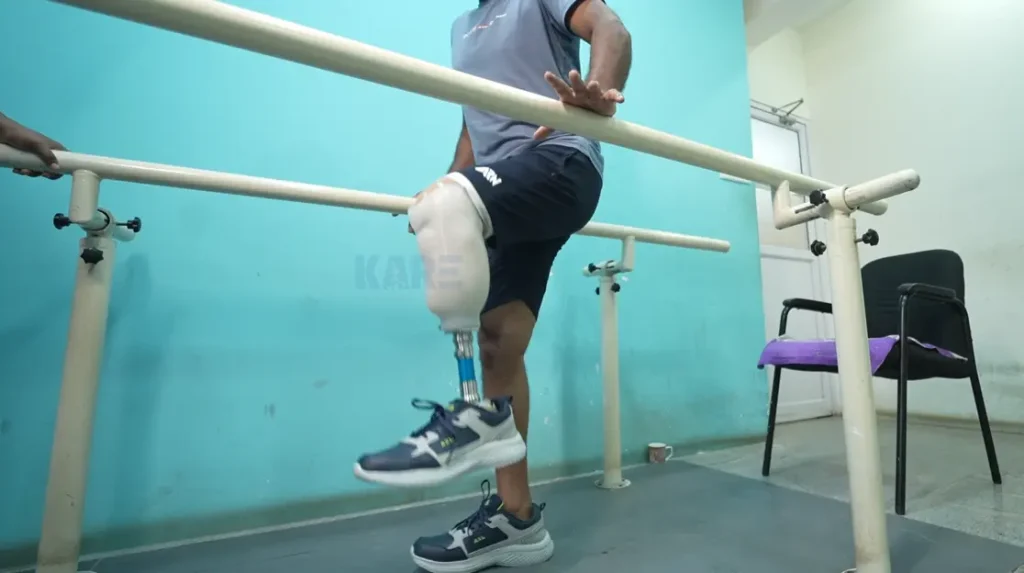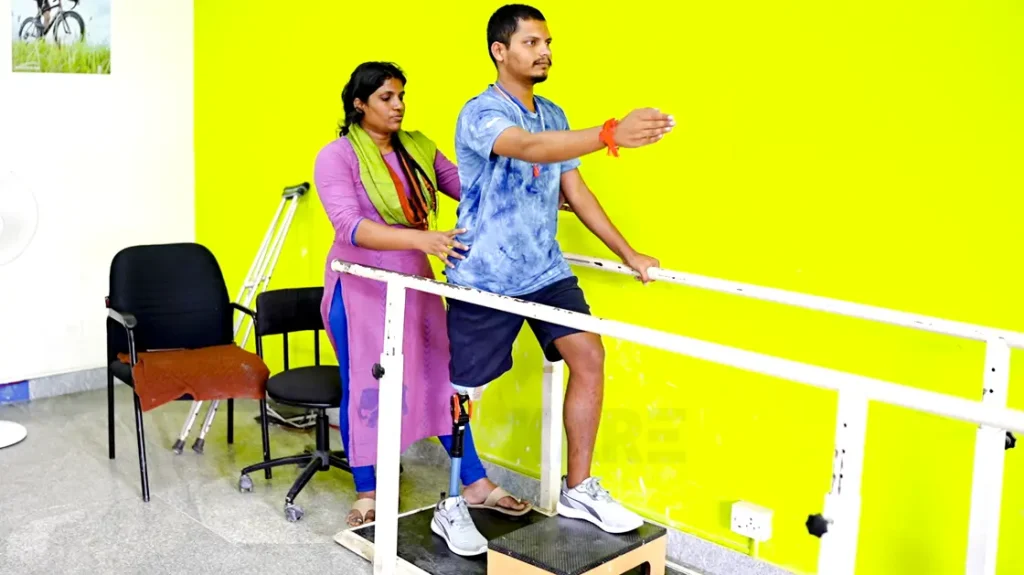We often take walking for granted, until an injury, surgery, or health condition makes every step feel difficult. Whether you are recovering from ACL surgery, a stroke, or facing age-related balance problems, losing the ability to walk confidently can affect your independence and quality of life. The good news is that with the right gait training exercises, you can rebuild strength, improve balance, and regain confidence.
This guide will walk you through:
- What gait training is
- 7 Gait training exercises that improve walking
- Simple routines you can do at home
- Exercises designed for stroke recovery
What are Gait Training Exercises
Gait training exercises are a physical therapy technique that helps strengthen weak muscles, improve coordination, and promote effective walking. It also helps individuals regain independence and confidence in walking using canes, walkers, or prosthetics. and reduce the chances of falls while recovering from stroke, Parkinson’s disease, and joint replacements.
It focuses
- Strengthening the muscles needed for walking
- Improving coordination and balance
- Correcting unusual walking patterns caused by injuries or medical conditions

It is commonly recommended after:
- A Stroke or neurological issues
- Surgeries like ACL reconstruction or hip replacement
- Balance disorders in older adults
- Amputation or prosthetic adaptation
- Weakness following injury
Gait training is usually done using parallel bars, treadmills, resistance bands, or walkers and canes, which help guide the process.
Why Gait Training Matters
Gait training works to:
- Correct abnormal walking patterns
- Improve muscle strength and build muscle memory
- Increase speed in walking and stride length
- Reduces the risk of falling
- Builds confidence in daily activities
Monitored practice and professional guidance in gait training help to overcome challenges and achieve better physical function, leading to confident movement.
7 Best Gait Training Exercises for Walking Balance and Mobility
Some common gait training exercises and procedures:
1. Range of Motion Exercises or ROM
Ankle circles, heel slides, and knee bends: help reduce stiffness and improve flexibility.
2. Strength Exercises
Sit-to-stands, leg extensions, heel raises: strengthen key walking muscles.
3. Obstacle Training
Step over cones or cushions: improves coordination and foot control.
4. Side-Stepping Exercises
Take slow, controlled side steps (with or without resistance bands): strengthens hips and improves lateral balance.
5. Target Stepping
Step onto marked spots on the floor: helps with stride control and accuracy.
6. Retro Walking (Backwards Walking)
Walking in reverse: improves posture and engages different muscle groups.
7. Balance Exercises
Tandem walking or using a balance board: reduces fall risk and increases stability.
Gait Training Exercises at Home for the Elderly
It becomes challenging to maintain balance, keep muscles strong, and remain mobile without falling as we get older. Therefore, gait training exercises at home can keep us safe while walking and improve stability.
1. Balance Exercises
These keep your stability and reduce falls
- Stand on one leg while holding onto a chair
- Heel-to-toe stance (placing one foot in front of the other)
- Standing with feet close together for a few seconds
2. Walking & Mobility Exercise
Improve walking and control stride.
- Heel-to-toe walking across the room
- Sideways walking with knees slightly bent
- Marching in place to improve circulation
- Stepping over soft objects like cushions

3. Strengthening Exercises
Build strong muscles for walking support and endurance.
- Sit-to-stand from a chair
- Heel and toe raises
- Seated leg extensions
4. Treadmill Training
- Begin at a slow pace with support from handrails
- Increase duration gradually for stamina and balance
Home Gait Training Tips
- Start with heel-to-toe walking, sideways walking, and sit-to-stand exercises, while holding onto a strong surface for support.
- Reduce hand support, add light ankle weights, or increase repetitions when you improve gradually.
- Keep exercise area free and wear supportive shoes.
- Consult a physical therapist for personalised exercise plans.
Gait Training Exercises for Stroke Patients
Gait training is crucial for stroke rehabilitation to regain walking ability, enhance balance, and strengthen muscles. These exercises are helpful when guided by a therapist:
- You can try sitting straight and lifting one leg, then slowly lowering it. Repeating with alternate legs for increasing hip mobility and coordination.
- Try pushing up from a sitting position to standing, then return slowly builds leg strength.
- Standing on one leg while holding onto a chair or wall by using less hand support improves stability
- Stepping onto a low platform, then stepping back down and repeating on both sides strengthens stride and balance
- Stepping forward and returning to the start. Adding small obstacles for a challenge.
- Stepping sideways slowly to enhance hip strength and lateral stability.
- Stepping to tap floor targets to improve foot control and precision.
Expert Tips for Safe Practice at Home
- Start simple (heel-to-toe walking, sit-to-stand)
- Use stable support like a wall or chair
- Add small challenges gradually (extra reps, light weights)
- Keep your floor space clear
- Wear proper footwear
- Get a personalized plan from a therapist if needed
Frequently Asked Questions
1. How can I improve my gait after ACL surgery?
Follow a gradual recovery plan:
- Week 1–3: Heel slides, quad sets, straight leg raises. Use crutches to prevent limping.
- Week 4–8: Step-ups, side-to-side walking, and stationary biking.
- Week 9+: Do single-leg stance, walk on a treadmill, and light jogging under supervision.
2. How do I fix my gait after a stroke?
- Weight shifting for balance.
- Step training with wall or bar support.
- Do some heel-to-toe walking to improve coordination.
- For safety use walkers or canes.
Tip: Advanced therapies like NMES or robotic gait training can speed recovery.

3. What exercises improve gait?
The exercises to improve gait include:
- Basic: Marching in place, heel raises, step-ups, walking with resistance bands.
- Advanced: Treadmill walking, lunges, backward walking, agility drills.
4. Can I do gait exercises at home?
Yes! Clear a safe space and try:
- 10 heel raises
- 10 marching steps per leg
- 10 step-ups
- Heel-to-toe walking for 5 minutes
Remember to consult with your therapist before starting.
5. What are the benefits of gait training?
The benefits of gait training include:
- Improved balance and coordination
- Reducing the risk of falling
- Improving strength and stamina
- Better walking speed
- Greater confidence and independence
Conclusion
Gait training exercises are a crucial part of recovery and rehabilitation following an injury, surgery, or neurological condition.From simple home routines to advanced therapy with professional support, these exercises can help you walk with strength, stability, and independence.
Therefore, at KARE Prosthetics & Orthotics, our expert therapists customise rehabilitation programs to help you walk confidently again.
👉Book a consultation with KARE Prosthetics & Orthotics today.



